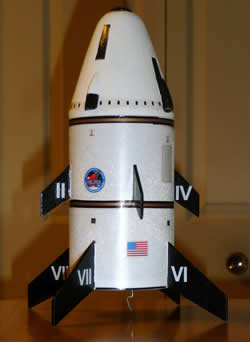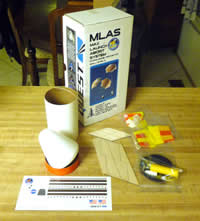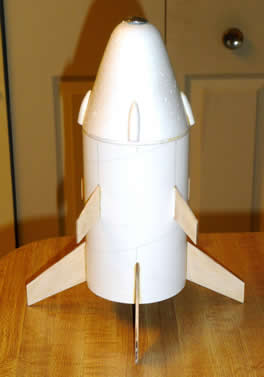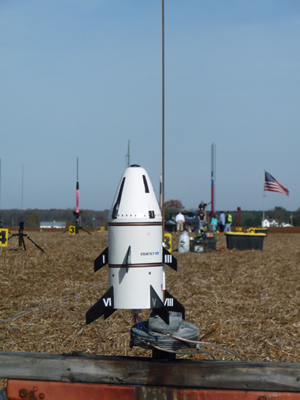| Construction Rating: | starstarstarstarstar_border |
| Flight Rating: | starstarstar_borderstar_borderstar_border |
| Overall Rating: | starstarstar_borderstar_borderstar_border |
| Diameter: | 3.46 inches |
| Length: | 9.00 inches |
| Manufacturer: | Quest  |
| Skill Level: | 3 |
| Style: | Scale |

Brief:
This is semi-scale sport model based on NASA's Max Launch Abort System (MLAS). It is quite stubby, being 3.5" in
diameter and a mere 9" long. It has only one recommended motor, the B6, and recovers in two parts on three
parachutes.
NOTE: Two RockSims were submitted. One is the stock build and one has added nose weight. You should assess the stability of your own model.
Construction:
Parts included in the kit:
- One 3.5" D v 5.5" L tube
- One nosecone shoulder ring
- Three laser cut rings for the motor mount and nose cone shoulder
- 18mm motor mount (tube, block hook)
- Kevlar® and elastic cords
- Three plastic 'chutes
- Two sets of four laser cut fins
- 1/8" lug
- Lag bolt
- Decal set
- Two foam MicroMaxx cones
The build requires the standard sandpaper, hobby knife, wood filler, wood glue. Foam safe white and black paint is
also needed.
The 10 pages of instructions are well written and are excellently illustrated. They include a marking guide for the motor mount, a ruler that you can cut out if you don't have one lying around and, of course, a fin marking guide.
The parts come securely packaged in a box vs. a plastic bag. This protects the wide, thin walled body tube, and helps both you and the environment. The box can be recycled into a reusable range box. At least, so sayeth the sticker on the end.
The motor mount assembly is standard, using both a thrust ring and a motor hook. Two centering rings are provided. The lower ring has cutouts to save a some weight. The Kevlar® cord is tied to the mount prior to the installation of the top ring. I used a *small* dab of 5-minute epoxy to secure it.
The body tube is quite thin for its size and I had concerns about squashing it along the way. I'm glad the mount
didn't grab while I was inserting it into the glue smeared tube. It survived my clumsy building skills but concerns
about flight durability remained.
The fin preparation and installation are also typical - sand, mark, glue (double glue joints are specified). The instructions have the fins filled after they are installed but I prefer to do this prior to installation.
The nose cone assembly consists of the foam capsule, a shoulder and a laser cut cardboard bulkhead. A heavy lag bolt is installed in the tip to provide the required nose weight. This bolt is also the attachment point for the nose cone's parachute. A second, very thin Kevlar® cord is tied around the bolt and is fed into the body when the 'chutes are installed. Attaching the cord to the bolt should keep all the parts together on recovery and will allow the cone to come down base first. The final step is to install the faux thrusters on the nose (which were faux on the real thing too). Here, you split the two foam MMX cones, sand to fit, and glue them on the capsule.
Finally, you also have to assemble and install the three plastic 'chutes. I added a length of elastic to each of the nose cone 'chutes to act as separate risers.


Finishing:
Prior to painting, you are instructed to fill the cone with thinned wood filler, which I did. The entire model is
then supposed to be painted with foam-safe paint. I chose to paint the lower part with 'regular' paint and the cone
with brush-on acrylics. I ended up using the paint that I had on hand.
The body was spray painted and the fins were painted with brush-on. I don't like spraying such small areas. The instructions also say to cover the entire body with a plastic bag, expose the fins and mask them off. Since I didn't spray them, I just masked with plain old blue masking tape.
Masking the cone was the most complicated part of the process for me since the surface of acrylic paint was not perfectly smooth and I had a fair amount of bleeding. I should have painted on a layer of the base coat before adding the black trim.
The kit provided quite a few decals including stripes, rivets, fin numbers and logos. The instructions do a great job showing where to position them. I HATE IT when you have a sheet of decals and have to guess where they go. Make sure you look at them carefully to separate the individual items (for example, the numeral 'I' decals were individually positioned on the paper but some of the other numbers were attached to one another). The decals were tough and came off their backing quickly and easily. As usual for me, I had some positioning problems and little ones tended to stick immediately. I'll chalk this up to operator error.
The overall results are that the rocket looks great as long as you back far enough off. But I like it! All these issues are mine and not the kit's.
Construction Rating: 4 out of 5
Flight:
Prep was more complicated than your typical LPR bird. I added the specified wadding and laid in the 'chutes in the
order specified. The body's 'chute went in first followed by the two capsule chutes. I opted for the B6-4 vs. a -2
because that's what I had. My RockSim model, which uses the as-built mass and CG, says the -4 was a better fit
anyway.
Well, it rose about 20' then arced over and core sampled. It's path seemed to be perpendicular to the 7-8 mph winds. The good news: the soft foam cone was muddy but not dented, the body tube was intact and all 8 fins stayed on. The ground was soft but the kit was sturdier than I expected.
I wanted to try an Estes C6-5 but was nervous about using a heavier motor, so I kludged up some nose weight. I won't embarrass myself with the details but it DID involve bubble gum (but no bailing wire or duct tape). In my haste, I didn't check the CG for future reference. The boost was good with some weather cocking. Success! The nose weight unit was lost at ejection but I since recreated it as best I could. It was around 0.3 oz.
Recovery:
Ejection on flight #2 was a bit late due to the weather cocking, but not bad. One of the two nose cone 'chutes
tangled, but one is enough for a soft landing.
Flight Rating: 2 out of 5
Summary:
I liked short stubby rockets and fell in love with the MLAS after seeing its launch photos and videos. This is a very
semi-scale representation, but I like it too!

The motor mount, laser cut fins, and recovery system are fairly standard. Painting is a little more complicated than most, but I seldom consider finishing when I think of skill levels. There are a lot of decals and their quality is good. The three 'chutes make prep a little more complicated, but still not difficult.
The negatives are a thin walled body and marginal stability. Quest will likely say that my building skills or the wind led to the problems with the B6 flight. Even with these issues I like the kit and it was refreshing to see someone go out on a limb and offer such a kit. Despite my low rating, I recommend buying one..or two.
I have added some weight to my nose and will try her again at the next launch. I went ahead and submitted the review since this could take a while.
Overall Rating: 2 out of 5
Other Reviews
- Quest MLAS By Jim Fields (January 27, 2011)
My son and I were on our most recent trek up to Stevensville to see Dave at Red Arrow Hobbies ( http://www.redarrowhobbies.com/ ) to pick up some kits he had ordered up for us for a Cub Scout build event. My son was cruising through the inventory, and yes it is nice to have a ‘real’ rocket/hobby shop to actually physically walk into, checking out all the different kits and ...
 |
 |
Flights
 |
 |
Sponsored Ads
 |
 |












D.S. (December 5, 2009)